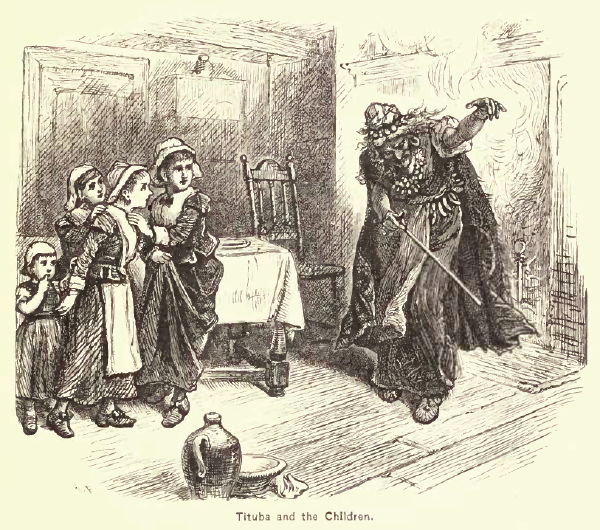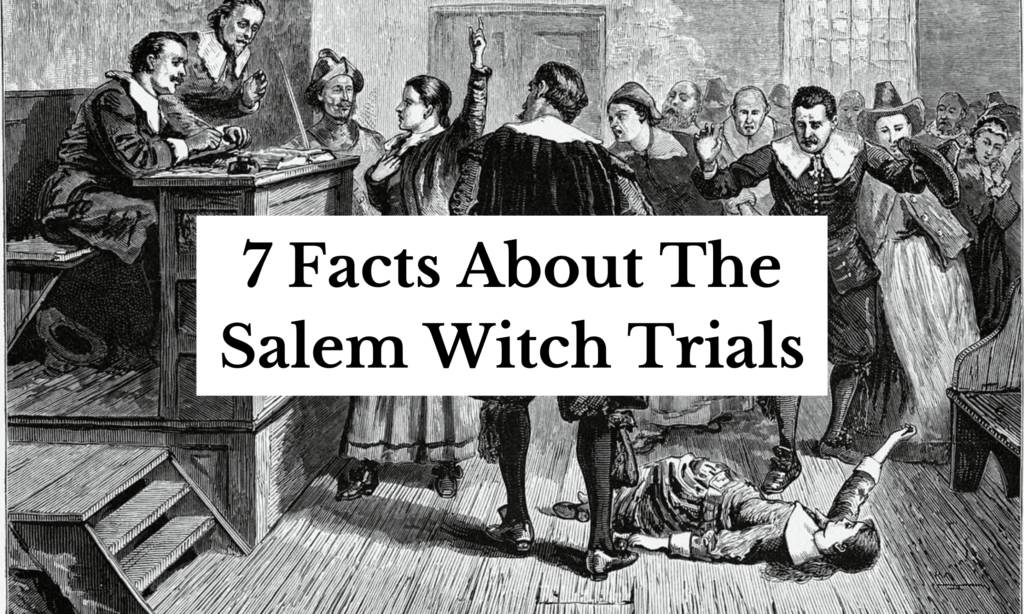Just outside of Boston, Massachusetts, lies a small town with a big history: Salem.
Salem was one of the first places in America to be colonized by the English. It is instantly recognizable as the home of the infamous Salem Witch Trials that took place between February 1692 and May 1693. Of the over 200 people accused of practicing witchcraft, multiple died in prison and 20 were executed for their “crimes”.
So, what were the Salem Witch Trials? Why did they happen? And what did they do to the suspected witches?
Here are 7 facts on the Salem Witch Trials.
7. Background of the Salem Witch Trials
Puritans founded Salem village during a mass migration to America from 1629 to 1640.
Although not the first witch hunt in colonial America (the similar Connecticut Witch Trials took place a few decades earlier), the Salem Witch Trials were the deadliest.
John Hale: ‘A Modest Enquiry into the Nature of Witchcraft‘
A lot of what we know of the Salem Witch Trials facts is in thanks to a clergy member at the time John Hale, who after initially supporting the trials, changed his mind, later writing an in-depth analysis of Salem’s dark year.
His book ‘A Modest Enquiry into the Nature of Witchcraft’ is the most significant source historians have on the trials and tells of their nature, and those accused, providing valuable insight into why they occurred.

Governor William Phips
When accusations of witchcraft began to fly, the Governor of Massachusetts – William Phips created a special court to deal with the cases, appointing his lieutenant William Stoughton as head.
Stoughton turned out to be a cruel individual, gleefully executing many of the accused using flimsy proof such as spectral evidence – more on that later.
Phips claimed he chose Stoughton as a person of best prudence and his cruel nature in the Court was entirely unexpected.
6. Andover and Topsfield Witch Hunts
Although the Salem Witch Trials are by far the most famous, it’s not the only area in colonial Massachusetts that endured a spate of religious hysteria where young men and women were accused.
Surrounding small towns just a 30-minute drive (or back then, a 4-hour horse ride) from Salem were also caught up in the panic. In Andover, over 40 were accused and 3 hanged. In Topsfield, a further 3 young women were executed using the same methods.
Around 19 towns, with Salem at their heart, make the 1692 Witch Trials the deadliest witch hunt in the history of colonial America.

5. What caused the Salem Witch trials?
By the end of the 1600s, the witchcraft fervour in Europe was finally dying down, after 300 years of (mainly) women being accused and executed as witches.
But across the sea, in colonial Boston, the Salem Witch Trials were just beginning.
Paranoia and Politics
By 1692, Salem was a hotbed of religious confusion and argumentative neighbors, with its Puritan minister, Reverend Samuel Parris, at the center.
Puritans believed women were inherently sinful and susceptible to the devil because of their weak and vulnerable bodies, and therefore more likely to become witches.
It’s no coincidence a lot of those accused had some direct link to Parris and his allies; people he had taken issue with or those who upset the established social norms of the colony.
Mass Hysteria
Mass hysteria is a phenomenon where a group of people act in a strange or unexpected manner, usually involving some sort of loss or change in function. The affected develop physical ailments that have no corresponding medical reason.
Most of the afflicted “victims” of witchcraft were young, persuadable, and more easily affected by mass hysteria.

4. The Start of the Salem Witch Trials
In January 1692, two little girls living in Salem began acting strangely. Elizabeth Parris and Abigail Williams, the 9-year-old daughter and 11-year-old niece of Reverend Parris, started having “fits” described as: “severe convulsions and other strange symptoms.”
After seeing the girls, John Hale wrote:
“These Children … were bitten and pinched by invisible agents; their arms, necks, and backs turned this way and that way and returned back again, so it was impossible for them to do of themselves.”
According to Hale, the nature of their behavior went past that inflicted by epilepsy or other known “natural” diseases.
Soon after, more girls apparently suffered the same illness.
It’s no coincidence these girls included Betty Parris, Ann Putnam Jr and Elizabeth Hubbard, all of whom had ties to officials in Salem and their families were linked to Reverend Parris.

Sarah Osborne, Sarah Good, and Tituba of Salem: The First Victims of the Salem Witch Trials
Accused by Elizabeth Parris and Abigail Williams on February 29th, Osborne, Good and Tituba were the first three women forced to participate in a Salem witch trial.
Sarah Osborne had upset the Putnam family with her non-traditional ways, keeping her own property and not attending Church for three years. She died in jail on 10th May 1692.
Sarah Good was, by all accounts, a bitter woman, angered by the loss of her financial status and home, and hated by her own husband. Horribly enough, her five-year-old daughter, Dorothy Good, was also arrested alongside her mother, making her the youngest of all accused witches. They hanged Sarah Good with four other women on July 29th, Dorothy was released 10th December, having been imprisoned since March.
Tituba of Salem was a black slave whose origins are unclear. Her skin color, coupled with rumors of stories of enchantments and voodoo, intensified the belief that Tituba dabbled in witchcraft. She was the first to be accused during the trials, and the only one of the three to confess – after being beaten by Parris.
Tituba was the only one of the three women to survive her jail time and was sold to an unknown person in April 1693 after Parris refused to pay her jail fees. No one knows what became of Tituba of Salem.
Whether the girls named the three women under duress by magistrates of familial influence is still discussed by historians today.

3. Proof of magic/being a witch
The Salem Witch Trials used some of the classic methods for testing if someone was a witch; third nipples (known as the “witches teat”) were a popular sign of witchcraft across both continents; as was the touch test where the suspected witch would touch the fitting individual and see if they continued to convulse.
But there were two particular methods that gained infamy during the Salem Witch Trials – Witch Cakes and spectral evidence.
Witch Cakes
To create Witch Cakes, they’d take the urine of those afflicted by witchcraft and bake it with rye meal and ashes into a cake. The cake would then be fed to a dog, who would then apparently reveal the name of the witch.
As talking dogs aren’t a thing, we can only assume the witch cakes test never panned out.
Tituba of Salem famously cooked a Witch Cake during the trials. Ironically, it was her work on the cake and knowledge of spells that later led to Tituba being accused of witchcraft.

Spectral Evidence
Spectral evidence was a favorite form of proof for William Stoughton during his tenure as head of the court during the Salem Witch Trials.
It was, frankly, even more ridiculous than the witch cakes.
The afflicted would claim they saw an apparition or shadow in the shape of the person torturing them. This apparition meant the accused witch had given the devil permission to occupy their form.
Obviously, this was rife for misuse and abuse, with the afflicted being able to point their finger at anyone they desired, and for it to be taken as evidence by people like William Stoughton.
Even back then though, some recognized it as a flimsy form of proof. But with someone like William Stoughton in charge, it was more than enough to condemn multiple people as witches.

2. The Victims of the Salem Witch Trials
200 people faced accusations of witchcraft in the months that followed. 17-year-old Elizabeth Hubbard and 13-year-old Ann Putnam Jr. were primary instigators throughout.
Hubbard filed 40 complaints, testified 32 times, and was directly responsible for the deaths of 15 of the victims of the Salem Witch Trials.
Putnam accused over 62 people in Salem town and, with her friends, seemed to have had a hand in all the executions of supposed witches. She is also the only one of the group to express remorse; apologizing in later life for her part in the Salem Witch Trials.
Too many people fell victim to the trials to name here, but their families never let the injustice rest. For the next few centuries, they fought to gain a pardon on behalf of their ancestors and sometimes succeeded.
Finally, in 2001, Massachusetts passed an act exonerating all the victims of the Salem Witch Trials, naming each as innocent.

1. How did the Salem Witch Trials End?
The Salem Witch Trials came to an abrupt end in May 1693.
On 29th September 1692, Governor Phips returned home from a brief stint away. He fast learned many high-profile individuals had been accused of witchcraft – including Phips’ own wife.
Many of these were convicted on the grounds of spectral evidence, thanks to William Stoughton.
The fervor of accusations, coupled with Stoughton’s enthusiasm in executing those accused, led Phips to draft a letter shutting down the court he had created. He instead developed a new version where spectral evidence was no longer accepted.
Although Stoughton initially led this court too, he quickly became frustrated that he could no longer kill at will. In January 1693, Stoughton attempted to regain his previous power by ordering the execution of all suspected witches who had had a temporary sentencing reprieve due to pregnancy. Governor Phips refused to allow his order to be carried out and Stoughton stormed from the court.
His replacement was far more merciful and after Stoughton’s exit, no more accused were convicted of witchcraft, and by May 1693 those still imprisoned had been freed. Regardless, the Salem trials remain a dark spot in American history and were later dramatized in the Arthur Miller play The Crucible.

Love history. Thanks for sharing these interesting facts. Some of them I knew and some I didn’t. Thanks.
Interesting. I haven’t learned about the Salem Witch Trials since I was in High School. Such craziness back in the day.